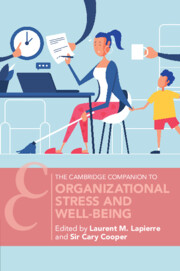Book contents
- Organizational Stress and Well-Being
- Cambridge Companions To Management
- Organizational Stress and Well-Being
- Copyright page
- Contents
- Figures
- Tables
- Contributors
- Introduction
- Part I Historical Evolution and Continued Relevance of the Study of Organizational Stress and Well-Being
- 1 From Occupational Fatigue to Occupational Health
- 2 Impacts of Stress and Well-Being on Organizations and Societies
- 3 Theories of Organizational Stress and Well-Being
- Part II Line Managers
- Part III Major Issues Relating to Stress and Well-Being
- Part IV Workplace Interventions Addressing Stress and Well-Being
- Part V Emerging Issues
- Subject Index
- References
3 - Theories of Organizational Stress and Well-Being
A Comparative Perspective
from Part I - Historical Evolution and Continued Relevance of the Study of Organizational Stress and Well-Being
Published online by Cambridge University Press: 23 February 2023
- Organizational Stress and Well-Being
- Cambridge Companions To Management
- Organizational Stress and Well-Being
- Copyright page
- Contents
- Figures
- Tables
- Contributors
- Introduction
- Part I Historical Evolution and Continued Relevance of the Study of Organizational Stress and Well-Being
- 1 From Occupational Fatigue to Occupational Health
- 2 Impacts of Stress and Well-Being on Organizations and Societies
- 3 Theories of Organizational Stress and Well-Being
- Part II Line Managers
- Part III Major Issues Relating to Stress and Well-Being
- Part IV Workplace Interventions Addressing Stress and Well-Being
- Part V Emerging Issues
- Subject Index
- References
Summary
With the shift to a post-industrial, service, and information-based economy, many more jobs are now defined by distinct features of a psychosocial work environment, rather than by material conditions. Accordingly, theoretical models derived from the social and behavioral sciences are required that identify health-adverse stressful aspects of work within organizations. Using a set of quality criteria, this chapter analyzes the similarities and differences of four such models, selected on the basis of available international research evidence. These models are termed ‘demand-control’, ‘effort-reward imbalance’, ‘organizational justice’, and ‘job demand-resources’. Their explanatory contribution, assessment, strength of empirical evidence, and policy impact are compared, and differences are emphasized in terms of their conceptual focus and stress-theoretical basis. Given some overlap, potential benefits of combining these different notions are also discussed, as health effects of cumulative exposure are of interest. In a final section, future considerations point to the need for innovative theoretical developments in view of new challenges of globalized, technologically advanced work and in times of new health hazards, such as Covid-19. Importantly, scientists are expected to contribute to the reduction of a substantial gap between available scientific knowledge and its implementation into practice.
Keywords
- Type
- Chapter
- Information
- Organizational Stress and Well-Being , pp. 65 - 90Publisher: Cambridge University PressPrint publication year: 2023



